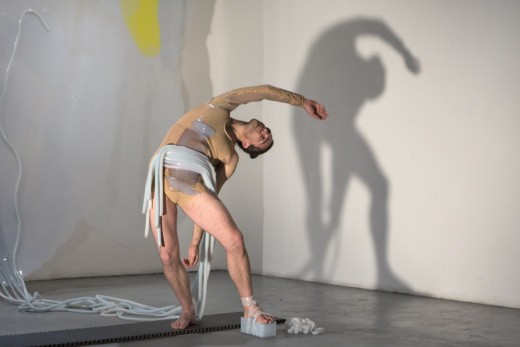 Martha Friedman: Pore, featuring collaborative performance with Silas Riener, 2015. Installation view: Locust Projects, Miami. Photo: Christian Hernandez
Martha Friedman: Pore, featuring collaborative performance with Silas Riener, 2015. Installation view: Locust Projects, Miami. Photo: Christian Hernandez
NOVEMBER 7, 2015–JANUARY 9, 2016
MEGAN VOELLER
It’s hard to imagine a better material with which to evoke the body’s four humors—an ancient medical theory long discarded by science—than Martha Friedman’s poured rubber. Phlegm never looked so sexy as it does in the form of a milky, translucent curtain suspended from the ceiling of Locust Projects. Next to it, a banana-yellow cascade (bile) gives off more primary color pop than you’d expect from a bodily fluid, but no matter. Sheets of black (the other bile) and blood-red rubber, stretchy and slick, complete the effect of standing inside a psychophysical abattoir.
I visited Friedman’s exhibition on an afternoon during Miami Art Week when twenty other spectators were pressed into the space. We were there to watch Friedman’s collaborator, dancer, and choreographer, Silas Riener, move with the sculptures. He entered the gallery nearly naked in a spandex loincloth. Each rubber sheet has an extension—in the case of cloudy phlegm, an umbilical cord of spaghetti-like tubes—that connects to a costume. (The blood sheet itself becomes a cape under which he quivered and shook.) Riener transitioned between the humors like stations, wriggling into a new garment at each and embarking on a dance inspired by the humor’s corresponding traits. Phlegm necessitated a study in passivity. Riener balanced (but barely) on a rubber block with the consistency of Jell-O strapped to his foot using loose spaghetti tubes. Black bile, conventionally linked with anger, occasioned a series of faintly masochistic backbends. Attached to the rubber sheet by a bodysuit, Riener played with how far he could stretch the material before it pulled him back. Friedman has said that George Balanchine’s The Four Temperaments (1946) was a reference point. Riener came closest to recalling the ballet with his pointe work during the movement devoted to yellow bile.
Friedman and Riener’s collaboration strikes a balance. Without him, her body-invoking sculptures take on a nerdy literalism. (Beyond the rubber sheets, Friedman deploys a lot of metal tubing that seems intended to suggest veins, spines, or the titular pore.) Without her objects, his choreography falls on the opaque side of abstract. Together they’ve created something tightly crafted, weird, and pleasingly intimate. Locust Projects wins, too, with one of the more memorable site-specific projects made for its space.









